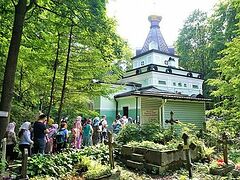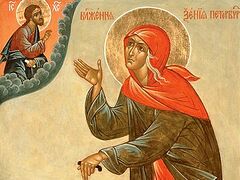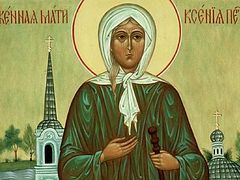Blessed Xenia of St. Petersburg is one of the most famous and venerated Russian saints. A great many people seek and have sought her help, and many get very clear answers. A chapel was erected over the saint’s grave in 1902 and it became one of the most visited places of Orthodox St. Petersburg. Today lots of people come there every day, asking for St. Xenia’s prayers and help. More than two centuries have passed since the holy woman’s death, but miracles through her prayers still occur.
When exactly, to whom, and how does the saint help? We can learn about this from her Life as well as the numerous testimonies of miracles she performed after her repose. We have collected some of them.
She calms hearts
Xenia Alferova, an actress, a TV presenter, the founder of the “I Am!” charitable foundation:
Blessed Xenia is my patron saint. I know well and feel that she helps me whenever I ask for her intercession. She is absolutely alive and dear to me. It’s like sharing with someone close to you, who will both protect and help you. That’s precisely the kind of relationship I have with her. There are so many such situations that it’s hard to give a specific example. To turn to her and seek her support is the first thing that comes to my mind when I am in a family conflict or overtaken by other problems. Little miracles occur every day.
You have a quarrel, and there is no strength to make up. But St. Xenia helps, calms your hearts, and after a while you suddenly feel softened, resentment vanishes and you find the strength to ask forgiveness—or the other person comes first to ask.
It may sound funny, but when I was a girl we knew nothing about saints, and my role model was the Soviet hero Zoe Kosmodemyanskaya. If I was to go to a dentist or endure something, I thought of her: “How did Zoe stand this? She managed, and I must manage too.” Now I have other heroes, but the first image that arises when I need to endure something is Blessed Xenia. She did not become a saint overnight: she endured unbearable hardships as an ordinary person. Since she lived not so long ago, we can imagine her life more or less concretely.
St. Xenia is so bright among holy women that today many know her Life at least in its rough outline. And however odd it may sound, when you are named after her you have to bear that name accordingly, because the proximity of a saint like St. Xenia imposes some additional responsibility. You think of the way you live more often. For me the power of her love and faith is unfathomable. She had such strong love for her husband, that for the salvation of his soul1 she imposed that great podvig on herself! How strong her faith in God must have been since she managed to change her life so radically, giving up everything! I realize I will never have the power of love or faith like hers, but I need to strive for this and approach at least a fraction of a percent.
 A festal service on the feast of Blessed Xenia. The St. Petersburg Theological Academy
A festal service on the feast of Blessed Xenia. The St. Petersburg Theological Academy
A helper in childbirth
Alyona, forty-five, a teacher from Moscow:
I love Xenyushka [a diminutive and affectionate form of the name Xenia.—Trans.] dearly, and every time I am in St. Petersburg I go to her relics. Besides, what makes her so close to me is that she was a widow.
We named our youngest daughter Xenia for a reason. When I was pregnant, at first there was a risk of miscarriage as a result of bleeding and a break in the placenta. It was very disturbing. At that time my sister was on a pilgrimage tour, visiting different holy places, including St. Petersburg, and praying for me. Later she phoned and told me that when she came up to St. Xenia’s relics, she felt so calm in her heart for me that she knew for sure that everything would be fine! And so it happened. Thank God our Xenia was born.
Xenyushka became even closer to me!
 By a wall of St. Xenia’s Chapel in St. Petersburg. The St. Petersburg Theological Academy
By a wall of St. Xenia’s Chapel in St. Petersburg. The St. Petersburg Theological Academy
She organizes honeymoons
Maria, forty-three, a teacher from Moscow:
We got married in church on February 6—Blessed Xenia’s feast-day. We weren’t prepared for the wedding at all—we didn’t know where we were going to live and all our things were in different apartments. Uncertainty awaited us after the ceremony. Only now do I understand that it was careless of us. We began to think whether to go somewhere or not. It was February, and we would have as much money as we were given for the wedding. With these thoughts I entered the parish library and asked the librarian, “Do you know where we could spend our honeymoon and not pay much?” She replied, “I know a place near Sergiyev Posad. It will be very good and inexpensive.” She took a piece of paper, one from a pile that had been cut for intercession lists, and wrote down the phone number with the name of the recreation center. I took the paper, thanked her and began to fold it in half when I suddenly saw these words printed on the back: “Blessed Xenia of St. Petersburg.” Apparently, the saint knew our absolutely unsettled state and made sure that the beginning of our family life was at least somehow memorable. We had a nice time at the recreation center on our own—we slid downhill, went skiing and ice-skating, and walked in the woods. On our way back we were informed that my grandma, who I lived with, had broken her arm. Very soon my husband’s mother had a concussion. At first we moved back and forth, taking care of them both. But St. Xenia’s gift to us remained in our hearts forever. If saints take care of us in such trifles, you can just imagine what happens with bigger things!
She strengthened people’s faith during the Soviet era
 St. Xenia’s Chapel before its restoration. A photo of the 1960s Natalia, fifty-nine, an engineer from St. Petersburg:
St. Xenia’s Chapel before its restoration. A photo of the 1960s Natalia, fifty-nine, an engineer from St. Petersburg:
In our days, on February 6 people line up outside of St. Xenia’s Chapel from early morning and straight from the entrance to the Smolensk Cemetery. When I first arrived there in the Soviet era, everything was in a state of neglect; it was impossible to get inside the chapel, the entrance was boarded up, but you could see debris inside and remains of a Soviet sculpture of some kind of discus thrower. All was in ruins—it was a sad sight.
I knew nothing about Blessed Xenia before and was even unbaptized. I studied at an institute and was the secretary of a Komsomol organization. We had the following saying that went around the institute during the end-of-term examinations, addressed to someone who passed a difficult exam: “It looks like Xenyushka has helped you!” I couldn’t figure out in any way who that Xenyushka was, where she worked or lived, and what the institute had to do with her. But it should be taken into account that the times were dangerous—whenever I went inside church, I saw a man in a black coat following me, observing what I was doing. I had wanted to get baptized for a long time but couldn’t, because at that time in Leningrad priests baptized people only upon producing a passport, and they immediately informed the “appropriate authorities”. People would lose their jobs and could no longer continue their education.
But one day I decided to find Xenyushka at the Smolensk Cemetery and went there, knowing very little about her. That amazing meeting really transformed my life. Wandering alone along the ruins, I headed for the ruined chapel, and then a little old woman came out to meet me: “Have you come to Xenyushka? I’ll tell you everything about her.” We talked for about two hours. She briefly related the Life of Blessed Xenia to me and spoke about the faith and love that had never stopped in this place despite the bans, destruction, and war. A prayer in verse that was composed during the Siege of Leningrad astounded me most of all. The old woman recalled that there were always people who, despite hunger and lack of strength, came there and prayed to the fool-for-Christ, believing that she would not abandon the city. She said of herself briefly, “Everyone I prayed to Mother Xenia for returned from the war.” Then I had only one prayer request—to get baptized. After a while, thanks to a travel voucher issued by the institute, I ended up in Yalta in the Crimea, where during a promenade on the Palm Sunday I stumbled across the Church of St. Alexander Nevsky that had been built in commemoration of the assassinated Emperor Alexander II (this was the link with St. Petersburg!). Its priests didn’t require anyone to produce a passport, so I was baptized there. And my life changed. I felt it at once.
Since that time, I have always advised everyone to turn to God and our city’s heavenly patroness in difficult life situations, and to go to our Smolensk Cemetery. Soon many churches were reopened, the number of the faithful increased, and miracles abounded at that time—help came almost immediately to everyone who came to the Church and turned to God.
I can testify to one more miracle. A few years later a friend came to see me. She had been married for eight years but suffered because she had no children. She just sobbed that day in despair, saying that there were no prospects and she was tired of going to all the doctors. I suggested that she not put it off but go to straight to the Smolensk Cemetery. But as is often the case, a person’s path to God isn’t always easy. A tram ran from my house and it usually took me about twenty minutes to get to the Smolensk Cemetery, but that day it took us two hours. The weather was also against us, and my friend suddenly felt unwell during the journey so she had to sit on a bench for a while. When we finally arrived my friend headed for the chapel to pray, while I waited a little distance from her and thought in passing that it would be nice if God sent me a boy. By then I already had two daughters. Two weeks later I discovered that I was pregnant and had no doubt that it would be a boy. And my friend gave birth to a son six months after me. We are both convinced that it was the help of Blessed Xenia of St. Petersburg.
 St. Xenia’s Chapel in the village of Sizma of the Vologda region. Photo: Vologdatourinfo.ru
St. Xenia’s Chapel in the village of Sizma of the Vologda region. Photo: Vologdatourinfo.ru
She arranges our life
Alexander, fifty-seven, Ramenskoye (the Moscow region):
I want to share my experience of asking St. Xenia of St. Petersburg—one of the most favorite saints in our family—for help.
I got acquainted with this saint via my wife Irina in 2005. She went on an excursion to the village of Sizma in the Vologda region. In terms of the number of pilgrims, the local St. Xenia’s Chapel is one of the most visited holy places of the region. The entire chapel is covered with requests for prayer and intercession.
After that we bought several books on the saint’s life and began to pray to her for my nephew and nieces, that they would find spouses for themselves.
First we prayed for my niece Natalia from 2007, after my elder brother’s (her father’s) death. She was twenty-one at the time. In 2013, Natalia got married.
Next, from the year 2010, I started to pray for my niece Tatiana after my sister’s (her mother’s) death. She was twenty years old. In 2017, Tatiana got married.
In 2010 I began to pray for my nephew Leonid, who was already twenty-five. Leonid got married in 2018. He first met his future wife, Xenia, during his sister Tatiana’s wedding party. Xenia, as it turned out later, had noticed him long before as Leonid used to stop by to visit her neighbors. But Leonid for a long time didn’t take Xenia very seriously because of their age gap (about ten years).
Our petitions for the nephew and the nieces varied. Whenever I visited any church and saw an icon of Blessed Xenia there, I would pray to her for them. I would also read the akathist hymn to her once in a while.
From 2008, when my wife and I moved to a suburb of St. Petersburg, we travelled to the Smolensk Cemetery every month and venerated St. Xenia’s tombstone.
Not long ago we relocated to a suburb of Moscow, but every year we travel to St. Petersburg to visit St. Xenia’s Chapel at the Smolensk Cemetery along with St. John Convent [in honor of St. John of Rila; founded by St. John of Kronstadt in 1900.—Trans.] on the bank of the Karpovka River to venerate the tomb of St. John of Kronstadt.
Our petitions to these saints are always answered quickly and very clearly.
 Mosaic of St. Xenia on her chapel in St. Petersburg. The St. Petersburg Theological Academy
Mosaic of St. Xenia on her chapel in St. Petersburg. The St. Petersburg Theological Academy
She takes care of those who are named after her
Photinia, forty, a social worker of the “Miloserdie” (“Mercy”) Orthodox aid service, Moscow:
Of all the women saints, Blessed Xenia immediately seemed the closest to me. Her podvig of love astonished me and became an example to follow. From a romantic city St. Petersburg became the place of Mother Xenia’s special presence, and going there to visit her chapel became my cherished desire.
The fact is that I converted to God in high school and immediately began to dream of an Orthodox family. Thanks to my father-confessor I realized that I should pray and trust God in this matter.
My husband and I were married in church in the summer of 2003, and in the fall, after the first trip to our friends who then lived close to the Smolensk Cemetery, we learned of my pregnancy. I instantly came up with a name for my daughter; there was even no doubt that the closest and dearest saint to me, with a name that I like, was Mother Xenia. And miracles began at this stage. My spouse, with whom I often have heated arguments, agreed to a ridiculous request. I said, “She’ll have your surname and patronymic, so let me at least choose something!” We began to visit St. Petersburg almost every year, and the first thing we did there was to go to Mother Xenia.
Now we have four children. This became possible thanks to the peaceful, hardworking, problem-free oldest daughter Xenia, whom her patron-saint didn’t leave even in a serious illness. Many of our friends went to the Smolensk Cemetery and brought us holy oil and holy water from there during those long months in a hospital.





